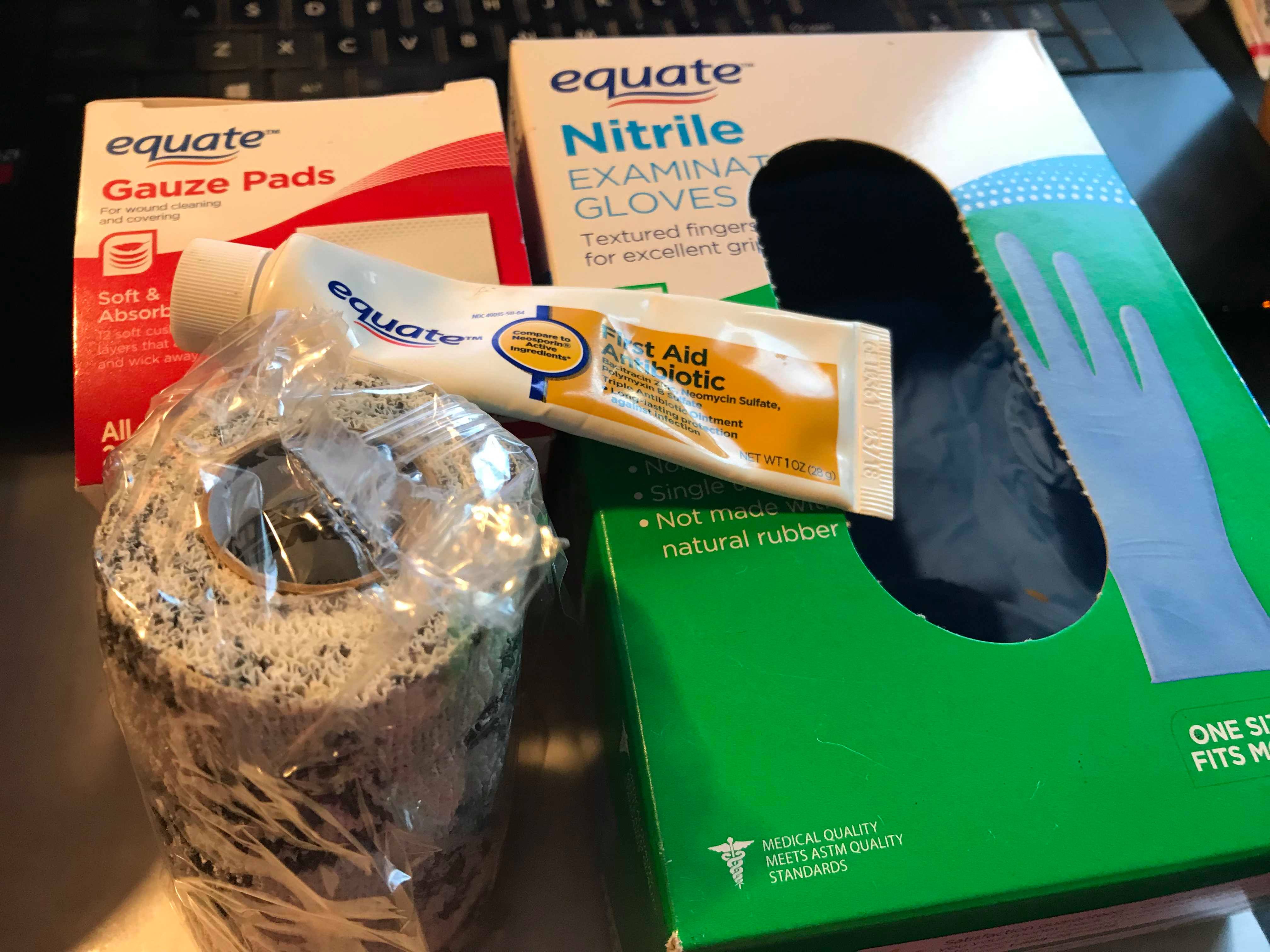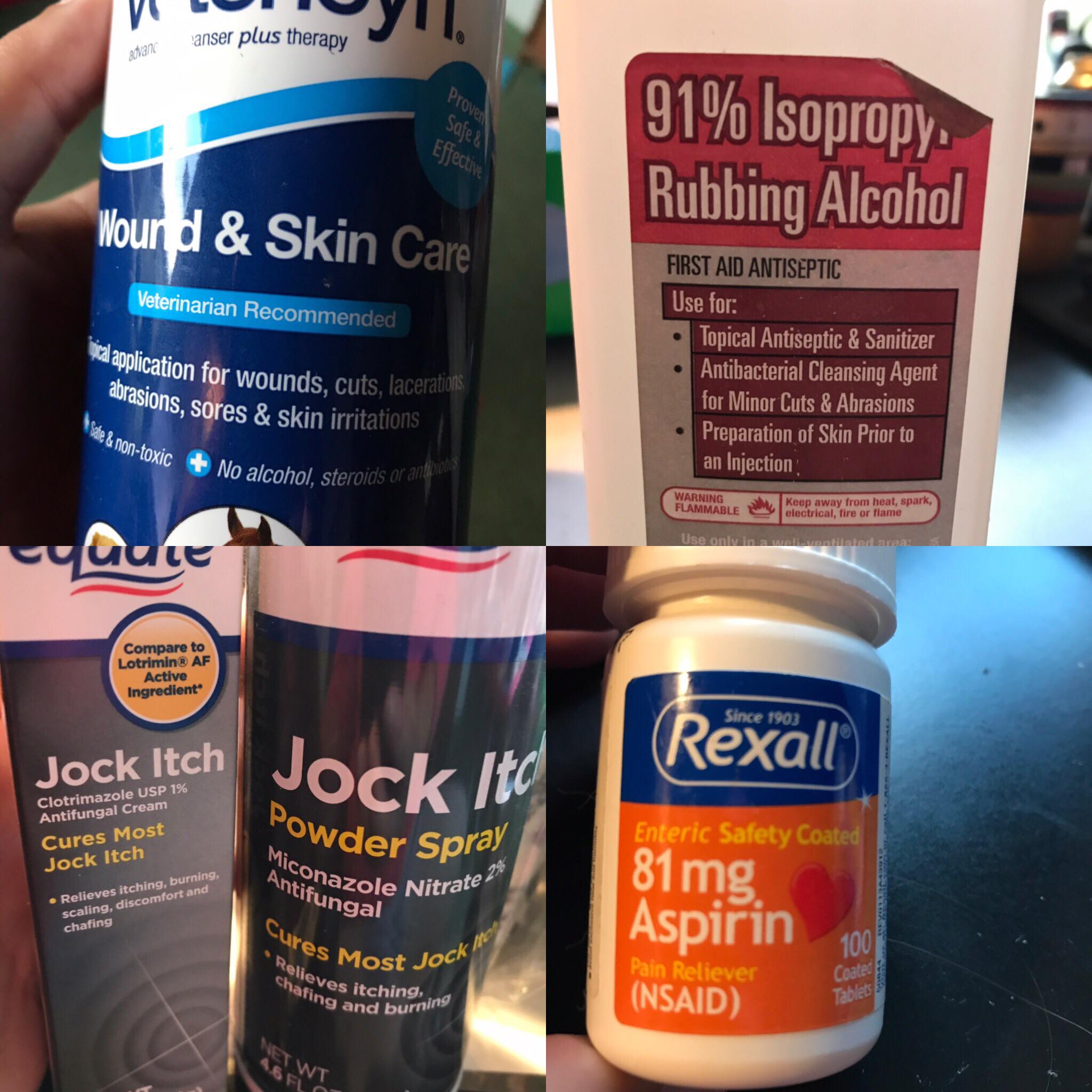A chicken first aid kit is essential for everyone who keeps chickens. Traci DeLore provides us with a great list of what to include.
No matter the size of your flock, eventually you will have to deal with some sort of medical issue. A well-stocked first aid kit can be the difference between a successful outcome and the alternative.
(Use your kit to treat Bumblefoot.)

I keep all my first aid supplies in a plastic dishpan to make them easy to grab.
At the very least, you should have some antibiotic ointment, gauze, and bandages on hand. However, to be truly prepared for a range of injuries, consider stocking a full array of first aid supplies to keep on hand.
Over my years of keeping chickens, here is the kit I have put together that allows me to handle just about any medical issue that arises with my flock. From respiratory issues to impacted crops to broken legs, I’ve had to deal with it all.
Towels
Towels that are too ratty to use any more, plus a bunch of cheap beach towels I picked up at the store are stacked and ready in a closet for any chicken emergencies.
The towels serve several purposes – protecting the work surface, containing any messes, and wrapping the chicken when necessary.
Towels – have lots of them handy!
Bandages

It’s handy to variety of items available for closing wounds. My chicken first aid kit contains everything from bandages to veterinary “super glue.”
I keep an assortment of bandages in my chicken first aid kit. Regular gauze is great for blotting wounds and non-stick gauze pads for bandaging wounds. I use some veterinary wrap whenever I need something to hold gauze in place. It’s stretchy and sticks to itself, but not to skin or feathers.
Butterfly closures are good for pulling together open wounds. I also have veterinary “super glue” that I use to close wounds.

Disposable gloves, antibiotic ointment, gauze, and veterinary wrap are staples of my first aid kit.
Medications and ointments
Antibiotic ointment is a must-have for your chicken first aid kit. Make sure it doesn’t contain lidocaine or other painkillers as those can be harmful to chickens.
It can be helpful to keep some other medications, creams, and ointments on hand as well. Low-dose aspirin can help poultry in pain. I use one quarter to one half of an aspirin per dose depending on the size of the chicken.

Wound spray, alcohol, a variety of ointments and aspirin for pain relief all have a place in my first aid kit.
An antiseptic wound spray is essential for cleaning injured areas. While isopropyl alcohol is a bit harsh for cleaning wounds, it is great for cleaning off your tweezers and other first aid tools. Clotrimazole (jock itch) cream is handy for treating hens with vent gleet and other fungal conditions.
Tools and other stuff

Disposable scalpels, tweezers, pipettes and syringes are all handy tools.
The short list here is disposable gloves, tweezers, scissors, and disposable scalpels. If you can add to that, pipettes or an eyedropper, and syringes and needles are all handy to have. You may think you’ll never need a syringe and needle, but I recently used mine to “deflate” a chick with a ruptured air sac.
I keep my chicken first aid kit supplies in a large plastic dishpan. First, this keeps the supplies together and makes them easy to grab. Second, the dishpan can be used if you need to soak your chicken’s feet for treating something like bumblefoot.
Resources
There are a lot of books out there that cover basic chicken and poultry health. Look them over and pick one that works for you. My go-to book is The Chicken Health Handbook, 2nd Ed. by Gail Damerow. I also use PoultryDVM.com’s symptom checker when new and unfamiliar health issues pop up. You can check off all the symptoms your chicken has, and the site will pop up a list of possible conditions.
Just like football, the best defense is a good offense when it comes to chicken health. Keeping a well-stocked chicken first aid kit is definitely one part of a good offense.
Traci DeLore grew up around chickens on her family’s farm, but didn’t start keeping her own chickens until she was in her 40s. Her desire to keep chickens came from a desire to have her own fresh eggs from chickens she knew were well cared for and happy. Traci started with six chickens – and then chicken math took over. These days, she has about 60 chickens — and three “rotten” ducks. (I say this because having ducks is like living with toddlers.) Traci also raises and processes her own meat chickens on occasion.













1 Comment
I’m new at keeping chickens, have recently acquired 10 Rhode Island Red hens 1 rooster 3years old. When collecting eggs I find a couple broken nonsaveable.
Is this normal if not what can I do.